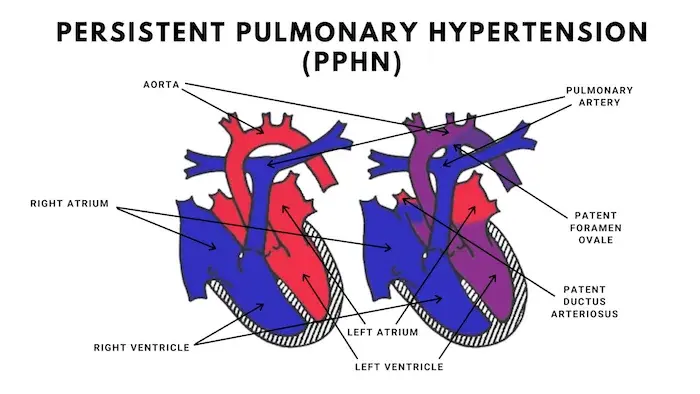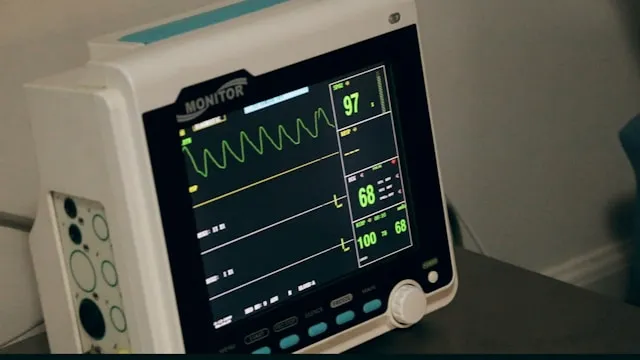Persistent Pulmonary Hypertension in Newborns (PPHN) is a dangerous but rare phenomenon of extreme lack of oxygen in a newborn's blood. The newly born child may look blue and appear to be gasping for breath due to trying to take in more oxygen from the atmosphere.
One major reason this might occur is that the blood vessels of the newborn baby do not dilate completely and hence do not allow the exchange of oxygen and carbon dioxide to take place in the lungs. All along the duration of the pregnancy, the baby feeds off of the mother via the placenta.
This also includes consuming oxygen from the mother's blood through the placenta. This is because the infant's blood vessels fully open up only after the baby is born, i.e., after 39 weeks. PPHN is observed in newborn patients who have full-term in the mother's womb. Rarely, it may occur in neonatal infants born after 34 weeks of gestation.
PPHN is a serious condition that can be life-threatening to the infant if the signs and symptoms are ignored and treatment is not given. Read along to know more about this phenomenon and how it can affect your newborn.
 Pulmonary hypertension - a raise in blood pressure in the newborn infant occurs when this is a change in pressure of the fetus's lungs as soon as the baby is delivered.
Study of nationwide children's org suggest that The origin of PPHN is undefined. Infants are more susceptible to PPHN if they possess certain factors.
Ideally, the fetus in the womb survives on the oxygen supplied by the mother via the placenta. The high blood pressure in the lungs forces all the blood directly to the heart through the fetal blood vessel called ductus arteriosus. The blood is then sent to various body organs for efficient functioning.
When the fetus is delivered, the first breath of air the child breathes in lowers the pressure in the lungs. This drop in pressure makes it easier for the blood to exchange oxygen and carbon dioxide in the lungs. The pressure drop also means that the blood is not forced through the ductus arteriosus, and this fetal blood vessel closes completely on the very first day of birth.
However, in infants with PPHN, that first breath of air does not change the pressure in the lungs. The blood continues to move through the ductus arteriosus, and there is no exchange of oxygenated and deoxygenated blood in the newborn infant. As a result, the high blood pressure in the lungs is persistent- thus giving the condition of persistent pulmonary hypertension. And since there is no more oxygen supply from the umbilical cord, the infant's blood severely lacks oxygen.
Also Read: How To Help Newborn With Gas?
Pulmonary hypertension - a raise in blood pressure in the newborn infant occurs when this is a change in pressure of the fetus's lungs as soon as the baby is delivered.
Study of nationwide children's org suggest that The origin of PPHN is undefined. Infants are more susceptible to PPHN if they possess certain factors.
Ideally, the fetus in the womb survives on the oxygen supplied by the mother via the placenta. The high blood pressure in the lungs forces all the blood directly to the heart through the fetal blood vessel called ductus arteriosus. The blood is then sent to various body organs for efficient functioning.
When the fetus is delivered, the first breath of air the child breathes in lowers the pressure in the lungs. This drop in pressure makes it easier for the blood to exchange oxygen and carbon dioxide in the lungs. The pressure drop also means that the blood is not forced through the ductus arteriosus, and this fetal blood vessel closes completely on the very first day of birth.
However, in infants with PPHN, that first breath of air does not change the pressure in the lungs. The blood continues to move through the ductus arteriosus, and there is no exchange of oxygenated and deoxygenated blood in the newborn infant. As a result, the high blood pressure in the lungs is persistent- thus giving the condition of persistent pulmonary hypertension. And since there is no more oxygen supply from the umbilical cord, the infant's blood severely lacks oxygen.
Also Read: How To Help Newborn With Gas?
 The symptoms of is pulmonary hypertension in newborns curable are observed no sooner than they are born. One of the most common signs that the child is suffering from PPHN is the child's skin appears pale and blue. This is a sign that the blood in circulation does not have oxygen bound to it. Other signs that the infant may be suffering from PPHN recovery time,
The symptoms of is pulmonary hypertension in newborns curable are observed no sooner than they are born. One of the most common signs that the child is suffering from PPHN is the child's skin appears pale and blue. This is a sign that the blood in circulation does not have oxygen bound to it. Other signs that the infant may be suffering from PPHN recovery time,
How is PPHN caused?
 Pulmonary hypertension - a raise in blood pressure in the newborn infant occurs when this is a change in pressure of the fetus's lungs as soon as the baby is delivered.
Study of nationwide children's org suggest that The origin of PPHN is undefined. Infants are more susceptible to PPHN if they possess certain factors.
Ideally, the fetus in the womb survives on the oxygen supplied by the mother via the placenta. The high blood pressure in the lungs forces all the blood directly to the heart through the fetal blood vessel called ductus arteriosus. The blood is then sent to various body organs for efficient functioning.
When the fetus is delivered, the first breath of air the child breathes in lowers the pressure in the lungs. This drop in pressure makes it easier for the blood to exchange oxygen and carbon dioxide in the lungs. The pressure drop also means that the blood is not forced through the ductus arteriosus, and this fetal blood vessel closes completely on the very first day of birth.
However, in infants with PPHN, that first breath of air does not change the pressure in the lungs. The blood continues to move through the ductus arteriosus, and there is no exchange of oxygenated and deoxygenated blood in the newborn infant. As a result, the high blood pressure in the lungs is persistent- thus giving the condition of persistent pulmonary hypertension. And since there is no more oxygen supply from the umbilical cord, the infant's blood severely lacks oxygen.
Also Read: How To Help Newborn With Gas?
Pulmonary hypertension - a raise in blood pressure in the newborn infant occurs when this is a change in pressure of the fetus's lungs as soon as the baby is delivered.
Study of nationwide children's org suggest that The origin of PPHN is undefined. Infants are more susceptible to PPHN if they possess certain factors.
Ideally, the fetus in the womb survives on the oxygen supplied by the mother via the placenta. The high blood pressure in the lungs forces all the blood directly to the heart through the fetal blood vessel called ductus arteriosus. The blood is then sent to various body organs for efficient functioning.
When the fetus is delivered, the first breath of air the child breathes in lowers the pressure in the lungs. This drop in pressure makes it easier for the blood to exchange oxygen and carbon dioxide in the lungs. The pressure drop also means that the blood is not forced through the ductus arteriosus, and this fetal blood vessel closes completely on the very first day of birth.
However, in infants with PPHN, that first breath of air does not change the pressure in the lungs. The blood continues to move through the ductus arteriosus, and there is no exchange of oxygenated and deoxygenated blood in the newborn infant. As a result, the high blood pressure in the lungs is persistent- thus giving the condition of persistent pulmonary hypertension. And since there is no more oxygen supply from the umbilical cord, the infant's blood severely lacks oxygen.
Also Read: How To Help Newborn With Gas?
What are the causes of pulmonary hypertension in newborns?
PPHN can occur due to a few medically possible reasons. However, research has not been able to determine why the infant's blood vessels do not open up quickly post-birth. A few factors that may cause the newborn baby to suffer from such a wicked condition are:- Abnormal lung development- the infant may suffer from abnormalities in the growth of the lungs and the blood vessels therein. This may fail to change the pressure in blood circulation.
- Meconium aspiration- is the medical term for 'breathing poop.' The fetus in the womb may have inhaled the sticky feces, which may cause a block in regular blood circulation.
- Infection- an infection may develop in the infant's lungs that may hinder the full potential of the newly formed lungs.
- Opened ductus arteriosus- a defect in the functioning or development of the ductus arteriosus can cause it to remain open even after birth. The lungs will thus remain under high pressure to facilitate blood circulation in the neonatal.
- Diaphragmatic hernia- the diaphragm separates the chest from the abdomen and gives the lungs the space it needs to develop fully. Diaphragmatic hernia is a life-threatening condition in which a hole in the infant's diaphragm fails in the lungs to develop.
What is Pulmonary hypertension of newborns symptoms?
 The symptoms of is pulmonary hypertension in newborns curable are observed no sooner than they are born. One of the most common signs that the child is suffering from PPHN is the child's skin appears pale and blue. This is a sign that the blood in circulation does not have oxygen bound to it. Other signs that the infant may be suffering from PPHN recovery time,
The symptoms of is pulmonary hypertension in newborns curable are observed no sooner than they are born. One of the most common signs that the child is suffering from PPHN is the child's skin appears pale and blue. This is a sign that the blood in circulation does not have oxygen bound to it. Other signs that the infant may be suffering from PPHN recovery time,
- Rapid breathing- the infant may appear to take quick breaths to find more oxygen.
- Rapid heart rate- you may notice the rapid beating of the heart in the newborn, which is an attempt to pump more oxygen to the different parts of the body.
- Flared nostrils- the nostrils may flare up to absorb more oxygenated air from the atmosphere.
- Cyanosis- the skin appears bluish and pale, a sure sign of a lack of oxygen in the circulating blood.
- Asphyxia- is the lack of oxygen or the presence of more carbon dioxide in the blood that may result in unconsciousness or lack of stability in the individual.
- Meconium staining- meconium is the stool that the infant passes when the child is born. Sometimes the fetus may pass stool when it is still in the womb- which is called meconium staining. It is observed when the amniotic fluid breaks. The fear is that the fetus may breathe in the meconium, which may cause a block in the normal functioning of the fetus.
- Low Apgar scores- Apgar score is a test to check the normal functioning of the infant 1 minute after birth and 5 minutes after birth. A low Apgar score can reveal that the child is not doing well outside the environment of the womb.
- Symptoms of shock- the baby appears rigid and may stare in one direction with an open mouth, gasping for air.
What are the advanced Treatments for PPHN?
Treatment for PPHN is a must, and the symptoms observed in the infant must not be ignored. Treatment options available focus on pumping maximum oxygen to the blood in circulation. This is done in the following way:- 100% oxygen- this is supplied to the infant via the nasal cavity. Short prongs or plastic tubes are inserted in the nostrils to release oxygen directly into the windpipe.
- Nitric oxide dilator- nitric oxide is a blood vessel dilator that is given as an injectable to dilate the vessels in the infant to improve blood circulation in the lungs.
- High-frequency oscillatory ventilation- is a high-end machine that delivers air in and out of the lungs. It is a breathing apparatus, and the treatment is given in the hospital.
- ECMO- Extracorporeal membrane oxygenation (ECMO) is a heart-lung bypass machine. The blood is passed out of the body, where the blood exchanges the carbon dioxide for oxygen and sends oxygenated blood back into the body. The process is similar to that of blood dialysis.
- Inotropes- inotropes are medicines such as Adrenaline, noradrenaline, and dobutamine that help to keep the blood pressure high. It helps the heart to pump blood to the lungs to get more oxygen from the lungs.
Prevention of PPHN -
It is impossible to determine how this condition takes place or when it takes place. However, the mother may take several precautions to ensure the child's safety.- Stop medication- certain medications taken during pregnancy may cause the underdevelopment of the lungs and other parts of the body.
- Improving lifestyle- maintaining a healthy diet with regular exercise can prevent the mother and child from health-related consequences.
- Keep infections at bay- pulmonary hypertension may result from a lung infection. To protect the infant, the mother must not fall sick during pregnancy.
Caution -
The infant's recovery may take a few weeks or months. Until then, it is the parent's responsibility to take care of the infant and take a few precautions, such as:- Ensure that the infant does not get a cold or the flu.
- Keep your infant away from large crowds, especially sick people.
- Ensure that the baby is screened for any possible underlying serious conditions.
- Keep all breathing devices and apparatus away from the infant.
Conclusion -
Pulmonary hypertension is a rare phenomenon with mortality rates below 10%. The condition can be life-threatening if the child is deprived of oxygen for long periods. Understand the needs and cries of the infants by noticing any symptoms they may show. This condition is not lifelong; the infant's lungs improve with time and age. PPHn is a treatable condition; you only need to get to the doctor in time to save your infant from the struggles of normal breathing.
Reviewed by







